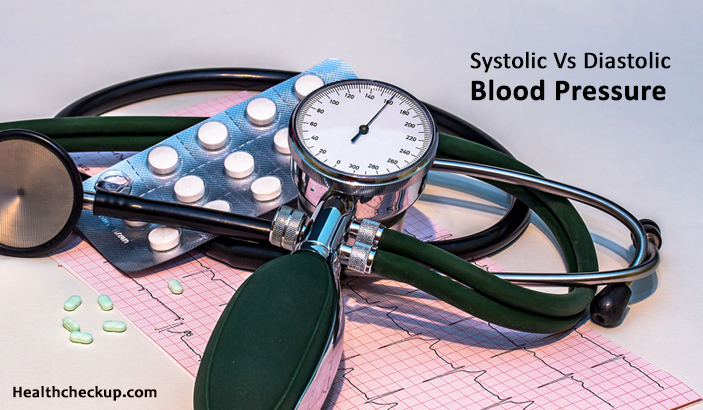What Is Blood Pressure Reading?
Blood pressure reading defines the health of the heart and the force with which the heart pumps the blood. The force exerted on the arteries is calculated with an instrument known as a sphygmomanometer which uses mercury in the column. The instrument comprises a cuff which is applied to the arm. The pressure is increased and then released in the cuff enabling the instrument to determine systolic versus diastolic blood pressure. The unit of blood pressure is mm of mercury (mmHg). Blood pressure reading has two figures with a slash mark for example 120/90 mm Hg. The larger number denotes systolic pressure while the smaller number denotes diastolic blood pressure.
What Is Systolic And Diastolic Blood Pressure?
Systolic and diastolic pressure occurs during the normal cardiac cycle. One half of the cycle focuses on providing the blood to the body and the other half focuses on filling the heart with blood. Both systolic versus diastolic blood pressure denotes pressure exerted by the blood on the arteries but at different times. Systolic blood pressure is the measure of pressure exerted by the blood on the arteries when the ventricles squeeze and push the blood from the heart to the body. Diastolic blood pressure measures the pressure of blood on arteries when the heart is in a relaxed state and the ventricles relax and ready to receive blood. During the relaxation period, the coronary artery is allowed to supply blood to the heart.
What Are The Various Values Of Systolic And Diastolic Blood Pressure?
Based on systolic versus diastolic blood pressure, the condition can be defined as normal, hypertension, and hypotension. In the hypertensive state, both the systolic and diastolic pressures are high while both are low in hypotensive condition.
Normal values of blood pressure in systolic pressure is less than 120 mmHg while diastolic pressure less than 80 mmHg. Elevated blood pressure has a systolic value of 120-129 mmHg while diastolic values less than 80 mmHg. Stage I hypertension has a systolic value between 130-139 mmHg while diastolic values between 80-89 mmHg. Stage II hypertension should have systolic pressure greater than 140 mmHg while diastolic pressure greater than 90 mmHg. A more severe condition, the hypotensive crisis is said to occur when the systolic is higher than 180 mmHg and diastolic is higher than 120 mmHg.
The hypotension is generally indicated when the systolic pressure is less than 90 mmHg while diastolic less than 60 mmHg.
Systolic Versus Diastolic Blood Pressure?
The following are the differences between the systolic versus diastolic blood pressure;
- Systolic blood pressure is the maximum pressure exerted by blood on arteries while diastolic pressure is the minimum pressure exerted by blood on arteries.
- While systole, the blood leaves the heart and in diastole, the blood enters the ventricles.
- Systolic pressure is an important parameter in adults and the elderly while diastolic pressure is commonly monitored in young people.
- Systolic pressure undergoes significant fluctuations as compared to diastolic pressure.
- Systolic pressure increases with age while diastolic pressure decreases with age.
| Systolic Pressure | Diastolic Pressure |
|---|---|
| It is the maximum pressure exerted by blood on arteries | It is the minimum pressure exerted by blood on arteries |
| The normal value is 90-120 mmHg | The normal value is 60-80 mmHg |
| Measured when the ventricle is contracted | Measured when the ventricle is relaxed |
| Signifies significant risk of cardiovascular disease | Less significant risk as compared to systolic pressure |
| Increases with age | Decreases with age |
What Are The Complications Of High Blood Pressure?
Following are the complications of high blood pressure;
Atherosclerosis
Although atherosclerosis is caused due to high cholesterol levels for prolong period however, high blood pressure plays a major role in increasing atherosclerosis by exerting excess pressure on artery walls.
Kidney Disease
Kidney and management of hypertension are associated in a cycle. High blood pressure damages the blood vessels of kidneys leading to kidney dysfunction. As kidneys are also responsible for controlling blood pressure, kidney disease may further increase blood pressure.
Heart Attack
High blood pressure may cause serious damage to the heart and may lead to cardiac arrest, ischemic heart disease, and hypertensive hypertrophic cardiomyopathy.
Stroke
Unmanaged hypertension breaches the integrity of blood vessels, weakens them, and causes their rupture. Stroke may also be caused due to hypertension-induces atherosclerosis.
Ocular Diseases
Unmanaged hypertension may also alter the vision by damaging the tiny blood vessels of the retina.
What Are The Complications Of Low Blood Pressure?
Following are the complications of low blood pressure;
Coma
Hypotension may lead to a coma due to a lack of sufficient blood supply to the brain.
Cardiovascular Disease
Hypotension, especially the orthostatic hypotension is considered as an independent risk factor for cardiovascular morbidity and all-cause mortality.
Stroke
Stroke may also be caused due to low blood pressure.
Dizziness
As the blood does not flow properly to the vital organs, the patient may have dizziness and feel disoriented.

Rohit Jain is an IPR Specialist and Medical Content Writing Expert. For over a decade, he has written several articles in the areas of female infertility, Erectile dysfunction, hemangioma, cervical cancer, monoclonal gammopathy of undetermined significance, mononucleosis, mitral valve disorder, nerve sheath tumor, shin splints, mild cognitive impairment, cellulitis, brain metastases, atelectasis, MCAD deficiency, lymphoma, sepsis, cardiac rehabilitation and metabolic disorder among others.









